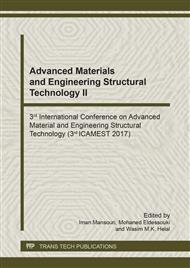p.75
p.80
p.85
p.90
p.95
p.100
p.106
p.112
p.117
Effect of Expansive Agent on Concrete Filled Steel Tube
Abstract:
The shrinkage of concrete is one of the main causes of cavity in concrete filled steel tube (CFST). In this paper, the effect of a kind of lab-made expansive agent on the deformation of CFST is studied. The laser displacement sensor combined with the round straight steel tube mould was adopted to test the deformation of concrete from the initial setting to 1 day after pouring, and the mechanical micrometer method was used to test deformation after 1 day in the laboratory. The full-scale model test was carried out to monitor the effect of expansive agent in CFST at the project site. The results show that, the addition of expansive agent produced significant expansion in the first 3 days, with the expansion basically compensating the autogenous shrinkage of the concrete; influenced by thermal deformation, the constraint action of steel tube to the core concrete in temperature rise stage was far greater than that in cooling stage. Compared with expansion produced in temperature rise stage, it is more important to produce expansion in cooling stage to solve the cavity problem of CFST.
Info:
Periodical:
Pages:
95-99
Citation:
Online since:
March 2018
Authors:
Price:
Сopyright:
© 2018 Trans Tech Publications Ltd. All Rights Reserved
Share:
Citation:


